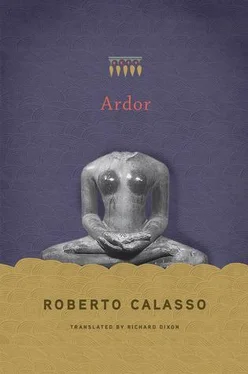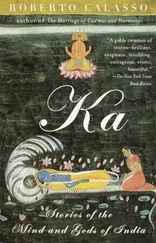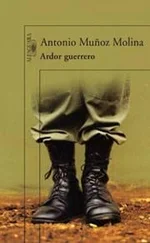What, then, will one see? In front of the fire of the oblations, the officiant is about to pour the ghee from a wooden spoon in his right hand, while in the other hand he holds an identical spoon, also full of ghee, but is careful not to use it. Why this complication? The second spoon is the shadow of the first, it is the double that emanates from the sacrificer and is bound to accompany him, threatening to overpower him.
The second spoon seems entirely superfluous. But if it were not there, it would mean that the presence of the spiteful rival is being ignored, making things even more dangerous. For the sacrifice to be perfect and complete, everything has to appear exactly as it is — evil as well as good, falsity as well as truth, disorder as well as order. To disregard just one of these powers means leaving it free to strike. Even nirṛti , which Renou boldly translated as “entropy,” a power opposed to “order,” ṛta , a nullifying power that lives in gaps, cracks, holes, crevices, has a right to its oblations, presented with no less devotion than that reserved for any other goddess (for that was how Nirṛti was portrayed: as a goddess “with a terrifying mouth”). During the stage in which the sacrificer is consecrated and initiated, he has to look for a crack or split in the ground, to make a special fire there and present the oblation with these words: “This, O Nirṛti, is your portion: accept it graciously, svāhā !” It is the only way to prevent Nirṛti from taking hold of the sacrificer when he is in the highly delicate condition of being consecrated and initiated — and so to avoid regression to the most helpless state of all, the embryo.
It should be no surprise, therefore, if the liturgical texts make continual mention of the risk of a spiteful rival bursting forth — or the possibility of the ceremony being usurped. And we should not imagine, as Heesterman suggests, that this corresponds to an historical phase in which the sacrifice, more than a religious ceremony, must have been like a tournament that often ended in death. The Vedic ritualists were accustomed to talking about the invisible as something very much present. They saw the gods huddled around the altar (around all altars, of all the sacrificers who celebrated a rite, over every valley and plain). And likewise they saw human enemies, those whose desires conflicted with those of the sacrificer and who sought nothing but his ruin. But in every crevice or hollow of the landscape they also saw the “terrible mouth” of Nirṛti, the goddess who disrupts every complete and well-ordered action and sucks it back into a vertiginous void. A goddess with powerful emissaries. Among these, dice and women. And so the person being initiated (and this is true for every sacrificer) abstained from gambling and sex during the days of the consecration.
* * *
At the end of the sacrifice, the sacrificer is empty, a wrinkled husk. For the underlying gesture throughout the ceremony is the tyāga , the “yielding,” the act of abandoning something — and potentially everything — to the divinity. But what has been abandoned isn’t lost. It travels, it is looking for its “place,” loka , in the sky: there it recomposes a body, a being. And the task is repeated over and over again. The main concern now is to survive on earth, to come out of the sacrifice unscathed. This is the moment for three oblations that revive the sacrificer. But the gods are jealous and astute: even now, when the ceremony is finished, they remain there, saying crossly: “These he should really be offering to us!” The sacrificer then insists: “What was emptied he fills again.” And so continues the skirmish between men and gods.
There was a very clear concern, during this last stage of the liturgy, to be rid of the gods. It was feared that they didn’t want to leave the field. They had been invited to go, they had received their gifts. But now they had to return to their august abodes. To leave men to their lives. Some gods had arrived on foot, others by chariot. Now they had to leave in the same way, laden with their gifts. And the sacrificer, during this delicate phase, needed help. So once again he turned to Agni: “The willing gods that you, O god, brought here, speed them each to their own abode, O Agni!” The sacrificer, like an impatient host, even went on to say: “You have all drunk and eaten.” In this way “he bids good-bye to the divinities.” Dry, consistent, with no note of self-righteousness or bigotry: this is how the Vedic ritualists spoke.
* * *
In Vedic India, every sacrificial rite is a motionless journey, a journey within a room, if we regard the sacrificial area as a vast open-air room. Broken down into hundreds, into thousands of gestures accompanied by formulas, formulas without actions, actions without formulas, it ended with a “bath,” avabhṛtha , that washed away all that was left of the journey and made it possible to return to normal life. In order to survive, that return was obligatory. The Taittirīya Saṃhitā says: “If they didn’t return down into our world, the sacrificers would go mad and perish.”
But there is one rite that is a real journey, a long journey lasting exactly a year. If a hypothetical sacrificer were immediately to start it all over again, his life would be an unending journey. It is the sattra , one of those rites where the sacrificer is also officiant. No ritual fee is therefore given to him. It would be like paying himself.
When the ritualists spoke about “those of times past” they were not referring to historical events but differences in liturgical practices. And the old days were always better. What they used to do then would always be beyond the capabilities of officiants today. Every rite contains moments of greatest concentration and tension. In a sattra lasting one year, “those of times past” used to celebrate three great days, called mahāvratas. But already by the time of the Śatapatha Brāhmaṇa only one day was celebrated. The ritualist notes bitterly: “Today, if someone celebrated in that way [like the ancients], he would surely crumble away like an unbaked clay pot would crumble away if filled with water.” That is what men today are like: fresh clay that easily disintegrates. But even if what can be done today is a pale image of what ought to be done, there is always a way of establishing an exact correspondence between the weakness of today and the intact forms of times past. This requires the patient, meticulous work of the ritualists.
In the sattras lasting a year the officiants built up a new body, piece by piece, limb by limb. Each segment of the rite corresponded to a part of this body. The first ceremony produced the feet, “for with the feet he moves forward.” On the day of the summer solstice, the viṣuvat , which divided the year in two, a new head was obtained. And, since the year consisted of two equal parts, in the first the fingernails had “the shape of grass and trees,” while in the second they assumed “the form of the stars.”
They knew very well that to celebrate a rite lasting one year was a risky business. Those who are consecrated to celebrate it “cross an ocean.” The opening rite is therefore “a flight of steps, for it is by a flight of steps that one enters the water.” This is the origin of the ghats , found throughout India even today, in every place where you enter the water: along the Ganges at Varanasi, but also on countless other rivers and lakes. The flight of steps, which in the West immediately evokes the ascent to heaven, for India was above all the proper way of descending into the waters, which mark every beginning. And so the second segment of the rite, the caturviṃśa day, was a point where the water reached as far as the armpits or the neck. A moment of rest before entering deep water. In the subsequent phases, which lasted more than five months, you had to swim, without a break. Until you reached a shallow bank, where the water became ever more shallow: until it reached the thigh, then the knee, then the ankle. It was the sign that you were reaching the solstice, the viṣuvat , which “is a base, an island.” A moment of respite, before throwing yourself back into the water and passing through stages that were the exact mirror image of the first months of the rite. Then again there was a shallow bank, when you reached the mahāvrata. Another key point. Then you came out of the rite, once again by a flight of steps. You had to leave in the same way as you entered.
Читать дальше












